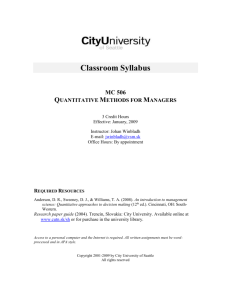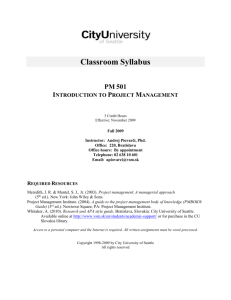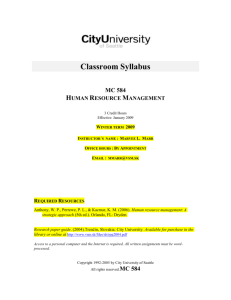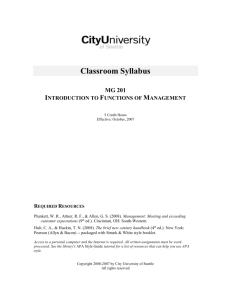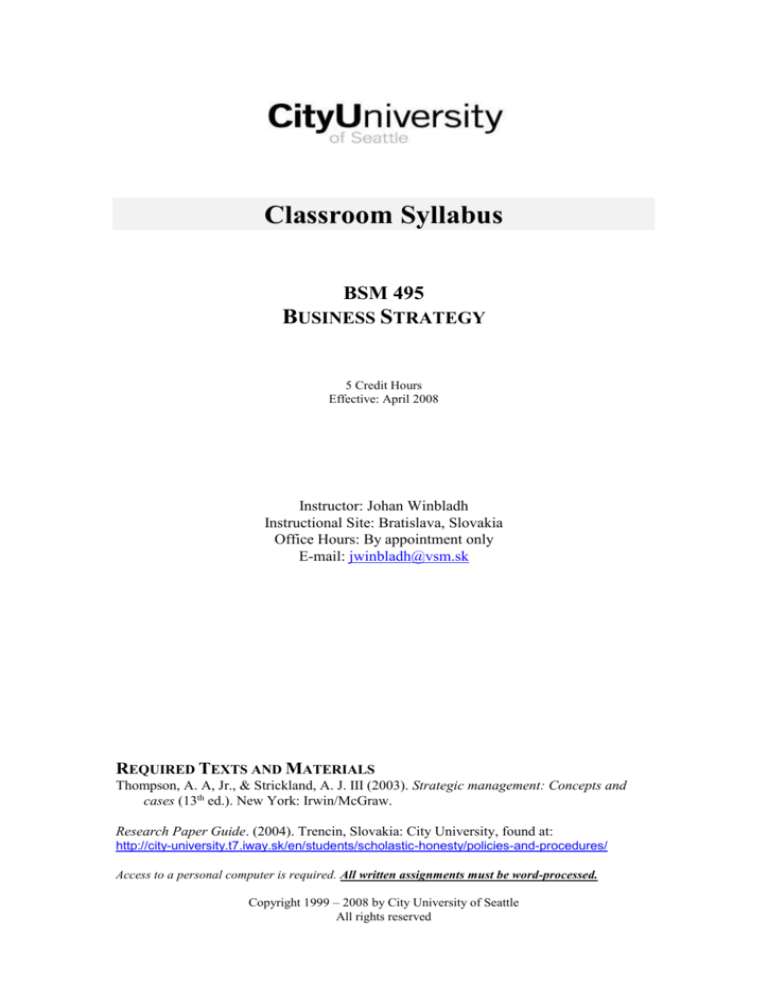
Classroom Syllabus
BSM 495
BUSINESS STRATEGY
5 Credit Hours
Effective: April 2008
Instructor: Johan Winbladh
Instructional Site: Bratislava, Slovakia
Office Hours: By appointment only
E-mail: jwinbladh@vsm.sk
REQUIRED TEXTS AND MATERIALS
Thompson, A. A, Jr., & Strickland, A. J. III (2003). Strategic management: Concepts and
cases (13th ed.). New York: Irwin/McGraw.
Research Paper Guide. (2004). Trencin, Slovakia: City University, found at:
http://city-university.t7.iway.sk/en/students/scholastic-honesty/policies-and-procedures/
Access to a personal computer is required. All written assignments must be word-processed.
Copyright 1999 – 2008 by City University of Seattle
All rights reserved
BSM 495
BUSINESS STRATEGY
This document provides an overview of the course foundation elements, assignments,
schedules and activities. For information about general City University of Seattle policies,
please see the City University of Seattle catalog. If you have additional questions about the
course, please contact your instructor.
Notification to Students with Disabilities
If you are a student with a disability and you require an accommodation, please contact the
associate dean as soon as possible.
Course Activities
Specific course activities and assignments may vary according to instructional delivery mode,
but they all incorporate and address the same Foundation Elements.
Scholastic Honesty
City University of Seattle expects each student to do his/her own work. The University has
"zero tolerance" for cheating, plagiarism, unauthorized collaboration on assignments and
papers, using "notes" during exams, submitting someone else's work as one's own, submitting
work previously submitted for another course, or facilitating acts of academic dishonesty by
others. The penalties are severe! A first offense can result in a zero grade for the course and
suspension for one quarter; a second offense can result in a zero grade for the course and
suspension for two or more quarters; a third offense can result in expulsion from the
University. The Policy and Procedures may be found at http://cityuniversity.t7.iway.sk/en/students/scholastic-honesty/policies-and-procedures/ or
www.cutn.sk/SH
In addition to providing your work to the instructor for grading, you must also submit an
electronic copy for the City University of Seattle archives (unless the work is specifically
exempted by the instructor). You will not receive a grade for particular work until and unless
you submit this electronic copy. The procedure for submitting work to the archives is to
upload it via the website http://bb.cutn.sk/cgi-bin/new_upload.pl or www.cutn.sk/Upload.
Files should include the cover page of the work with the student name, instructor name,
course name and number, and date. File names should indicate the type of assignment, such
as “researchpaper.doc”, “casestudy.doc” or “ thesis.doc” (student name should not be a part
of the file name because the system adds it). All files received into the archives are
submitted to www.TurnItIn.com for plagiarism checking.
Late paper policy
No late papers will be accepted. Do your work early to manage even if the computer crashes.
Try to be on the safe side. If you for an extraordinary reason, i.e. longer period of illness,
need an extension, ask for the extension before the deadline, not after.
COURSE DESCRIPTION
This is a capstone course that provides the student an opportunity to integrate discrete skills
gained from prior coursework in general business, accounting, marketing, management,
business law, communications, operations, human relations, and information systems.
Students address business finance, growth and management issues, and problems, viewing
them from multiple perspectives.
The objectives of this course are to foster clarity and depth of learning for students at the
culmination of their business education, and to provide a means to measure program learning
outcomes.
BSM 495 SYL Page 2
Eff:04/08
This course utilizes the case study method in which instruction is based on facts or problems
as they present themselves to a businessperson. Each case is presented with an atmosphere of
reality. The case studies require the student to research and evaluate qualitative and
quantitative information, synthesize pertinent data, analyze and define problems, reach
conclusions, and present his or her findings in writing, as occurs in a business. The focus of
the case study method is decision-making. The course also utilizes a major project to help the
students synthesize their learning.
Prerequisite: Prior to enrolling in BSM495, students must be in their last quarter of study, or
have completed the Undergraduate Core and Business Core degree courses for their degree
program as specified in the current City University Catalog, except for BSM 495. Any
exceptions must have special permission from the BSBA Program Director.
LEARNING GOALS
Upon the successful completion of this course, you will be able to:
1. Analyze industry and competitive conditions in a dynamic market setting so as to further
the success of the business;
2. Identify strategic business issues and problems from many functional viewpoints;
3. Use production, marketing, accounting and finance, and human and information resource
management to make sound decisions from a company-wide perspective;
4. Apply a team approach to business problems;
5. Evaluate a company's situation, options, and future prospects;
6. Apply strategic initiatives through:
a. environmental scanning of marketing opportunities and threats;
b. reading and analysis of financial statements;
c. financing, financial leverage, cash flow management, and capital allocation
decisions;
d. organizational group dynamics, negotiation, and problem-solving;
7.
Plan and budget for a business over time;
8.
Analyze global issues and their impact on strategic decision making in an enterprise;
9. Communicate both orally and in writing, business planning, concepts, and processes;
10. Use computer skills in planning, business analysis, and communicating data in written
work.
CORE CONCEPTS
To achieve the goals of this course, you will need to master the following core concepts:
1. Accounting principles;
2. Business plans;
3. Business policy;
4. Business strategy;
5. Distribution systems;
6. Ethics;
BSM 495 SYL Page 3
Eff:04/08
7. Finance in businesses;
8. General management principles;
9. Human resource management practices;
10. Information systems and business technology;
11. Operations management practices;
12. Organizational behavior;
13. Project management;
14. Strategic planning.
RELATIONSHIP OF COURSE TO PROGRAM CURRICULUM
This is the final course in the BSBA degree program. Students will be doing a final project
which integrates aspects from all other course work in this particular course, and which they
are expected to demonstrate the culmination of their learning.
RECOMMENDED SUPPLEMENTARY RESOURCES
As a City University of Seattle student, you have access to library resources regardless
of where and how you are taking this class. To access the resources that are necessary to
complete your coursework and assignments, visit the library menu in the CU portal at
http://my.cityu.edu/ or the CU Slovakia library at http://library.cutn.sk/
Search the CU Slovakia library’s online catalog to locate books and videos, and use the Web
site Directory to find links relevant to your course. This site will also help you access City
University of Seattle’s online databases for journal, magazine, and newspaper articles, or you
can access them directly through the portal.
For additional help, visit the library or submit your question in the “Contact us” section of the
Slovakia library’s home page.
PRINT RESOURCES
The following selections are regarded as "classics" in strategic thought and strongly
recommended as either an accompaniment to this course or as postgraduate reading:
Porter, M. E. (1980). Competitive strategy. New York: Free Press.
Michael Porter has written additional books as sequels to Competitive Strategy [using
the same title, Competitive Strategy, along with a specific topic, such as competitive
advantage, that is the focus of the book]. These sequels are also very useful for this
course and are based entirely on the material contained in the original edition.
Tzu, S. (1983). The art of war (Clavell ed.). New York: Delta.
There are numerous editions of Sun Tzu's Art of War. All of them are helpful. The
specific edition cited in this syllabus is notable for its simplicity in style and
presentation.
The following publications provide comprehensive financial information used for company
analysis and industry research:
Value Line Investment Survey - a publication of Arnold Bernhard & Co. (covers
1,700 companies). The information is also available at the URL:
http://www.valueline.com
BSM 495 SYL Page 4
Eff:04/08
Key Business Ratios - published by Dun & Bradstreet in bound form. (14 significant
ratios on 800 different lines of business listed by SIC Code). Also available at the
URL: http://www.dnb.com
Moody's Manuals - owned by Dun & Bradstreet (various databases on stocks and
bonds). The URL is: http://moodys.com
Robert Morris Associates - financial ratios for various industries.
Standard & Poor's - similar to Moody's Manuals but organized alphabetically rather
than by trade categories. The URL is: http://www.stockinfo.standardpoor.com
OVERVIEW OF COURSE ACTIVITIES AND GRADING
The grade you receive for the course will be derived using City University of Seattle’s
decimal grading system, based on the following:
Assignments
Business Simulation Project, “The Business Strategy
Game”. New version your instructor will explain.
Case Studies
In-Class Discussion
Oral Presentation of Business Plan
Written Business Plan
Final Exam
20%
10%
10%
10%
30%
20%
TOTAL
100%
Please see the current City University of Seattle catalog or consult your instructor for
guidance in determining your decimal grade.
EXPLANATION OF ASSIGNMENTS AND GRADING
BUSINESS SIMULATION PROJECT
With the other members of your team, you will manage a computer-simulated business,
addressing issues and problems of all divisions, including global expansion over a span of
years. Each team will be in head-to-head competition with other student-run companies in the
same industry, confronting market and competitive moves and choosing among alternative
courses of action. Preliminary from the first week until eight week of the course, one Game
(year) per week is planned.
We have a new game; the instructor will explain it.
CASE STUDIES
Each student will be required to write/prepare one case study per week. You are allowed to
write a maximum of one page. One student will present the case to class (when we have
classes); no PowerPoint or extra preparation should be needed. Students are required to take
part in the follow-up and case discussion and to present conclusions to the class
Case Study Method
Instruction is based on facts or problems as they present themselves to a businessperson.
Each case is presented with an atmosphere of reality. The case studies require the student to
research and evaluate qualitative and quantitative information, synthesize pertinent data,
analyze and define problems, reach conclusions, and present his or her findings orally and in
writing, as occurs in a business. The focus of the case study method is decision-making.
BSM 495 SYL Page 5
Eff:04/08
How to work with case studies
Your instructor will assign case studies for you (the class) to analyze (maximum one case per
week). Each case analysis should be treated as a problem presented to you by your
company’s top management for analysis and decision recommendations, where applicable.
Hence, it should demonstrate the qualities of thorough and relevant research, logically sound
analysis, and focused professional presentation (writing). To complete this kind of case, your
presentation (paper) on each of the assigned cases should include the following elements:
MAX. 500 words, single-spaced – Your submission should not be more than 1 page (+
extra pages if needed for charts, images, or necessary attachments)
Imagine you are a strategic management consultant asked to provide an executive with your
valuable recommendations of what should be done and why (in some cases how it should be
done). The structure is up to you, but it is ADVISED to address the following parts:
1/ BRIEFLY Identify the problem(s)
2/ BRIEFLY discuss relevant details
3/ Provide your recommendation(s) – this adds the greatest value to the company
4/ Provide reasons for your recommendation(s) (explain to the executive(s) why your
recommended action or strategy is the best).
Please note that points 3 and 4 provide the greatest value to the executives.
We cannot stress strongly enough the importance of preparing for class by completing
the assigned readings. You will not be prepared to participate in class if you have not
studied the material in advance.
Grading Criteria for Case Studies
Identification of strategic issues (point 1)
Thoroughness of analysis and recommendations (points 3 and 4)
Application of course material (point 2)
Evidence of critical thinking
Professionalism demonstrated through grammar, spelling,
punctuation, syntax, organization, and reference methods
TOTAL
15%
50%
15%
10%
10%
100%
Also make use of the “Case Tutor” file which will help you in your analysis and discussion.
IN-CLASS DISCUSSION
During this course you will be expected to contribute to each class discussion and every
computer simulation session. You will be graded on that participation. Negative
contributions such as side discussions with other class members, mobile phone interruptions
and other distractions will cause your grade to be marked down.
During class you will formulate relevant, cogent questions to be asked. The questions must
reflect attentiveness to the material presented, thoughtful consideration of issues the business
faces, and the depth of strategic thinking. You might ask for additional explanation of unclear
parts of the presentation, comment on strengths and weaknesses in the business, assess the
feasibility of recommendations, or offer alternatives (with supporting information). You are
expected to ask a minimum of one question in each meeting of the class.
Grading Criteria for In-Class Discussion
Relevance of topic
Clarity of content presented
Depth of content presented
Class discussion generated by the student
TOTAL
BSM 495 SYL Page 6
25%
25%
25%
25%
100%
Eff:04/08
BUSINESS PLAN
Each student will develop a business plan for a new or existing business. The business plan
will require students to synthesize knowledge from all areas of the business curriculum and
apply it to an original plan for a business.
A business plan is a written document detailing the operational and financial aspects of a
company. Like a road map, it helps determine where you are, where you want to be, and how
you are going to get there. It forces an executive/manager to consider all aspects of initiating
and operating a viable business. It keeps a company in touch with its goals, potential risks,
and rewards. It may be the crucial factor convincing investors or company management to
provide financing.
A good business plan also serves as a communications tool to familiarize sales personnel,
suppliers, and others with the company’s operations and goals. It helps students develop as
managers, providing practice in thinking about competitive conditions, promotional
opportunities, and situations that are advantageous to the business. It saves money and time
by focusing activities, establishing control over finances, marketing, and business objectives.
Business Plan Brief (loss of 30% of final grade if not handed in, on time)
In no more than two typed, double-spaced pages, using outline format, summarize your
company's vision and intended strategy, including a description of your product/service, a
summary of your functional level strategies, and a summary of your forecasts for decision
rules and approaches for raising capital. Be sure to highlight what makes your firm unique.
Include a list of your top management team and their roles. This will give the instructor an
opportunity to give you guidance on your project by the fourth or fifth week of the course.
You must be prepared to present your business plan outline to the class.
Requirements for the Business Plan
The format of the business plan will include the following list of elements:
1. Title Page
Include the student’s name and the name of the company, the instructor’s name, the class
title, course number, and start date.
2. Table of Contents
Provide a sequential list and pagination of the sections of the business analysis.
3. Executive Summary
Provide a synopsis of the business plan that summarizes the main points.
4. Mission, Vision, Goals and Objectives
Include a statement of the purpose of the business along with a picture of where the
business is going and what future you anticipate for it. Provide goals and objectives and
how they will be achieved.
5. Company Operational Plan
Provide a basic description of the company, its structure, management, staffing, location,
plans, and policies for human resources, quality management, major stakeholders and
strategic alliances, and strengths, and weaknesses.
6. Product Strategy
Review the product or service and what makes it unique and competitive. Future research
and development plans, production, and distribution are part of the product strategy.
7. Market Analysis and Plan
Define the market, the demographics and psychographics of the target customers,
BSM 495 SYL Page 7
Eff:04/08
competitors' products or services, and business and environmental risks and
opportunities. Delineate the product concept, pricing, distribution, and communications
strategies covered in this section. Develop sales projections and revenue forecast. Be sure
to discuss what industry this company is in, the strengths and idiosyncrasies of the
industry, and the company’s position in the industry.
8. Financial Plan
Outline the company's capital requirements, sources of funds, profit projections, and
financial strategies. Develop revenue and expense financial projections for four (4)
financial periods in financial statement format. Integrate information, such as your
revenue forecast, from the other areas of your business plan into these projections.
Complete a break-even analysis and a ratio analysis, and comment on the company’s
situation. What is the financial situation? Is the company profitable, if not when will it
be? If it is a start up company, what will be your initial capital needs? If your company is
an ongoing concern, what will be your ongoing capital needs, and how will you meet
them? Analyze and demonstrate.
9. The Company’s Future
Describe the future of the company. What strategic decisions does it face now that will
affect its future? What recommendations do you have for the company? What strategies
would you use to implement these recommendations?
10. Bibliography
Proper use of APA style is required.
Grading Criteria for Business Plan
Definition of business and competitive arena
Clarity of plan and justification
Logic and depth of marketing plan
Appropriateness of organization and management structure
Viability of strategy and logic of justification
Accuracy of financial data across the plan
Professional presentation, including proper grammar,
spelling, punctuation, syntax, and reference methods
TOTAL
15%
20%
15%
15%
15%
10%
10%
100%
ORAL PRESENTATION OF THE BUSINESS PLAN
Each student will make an oral presentation of their business plan and will summarize the
business, its strategies, and expected results over time. The presentation should show
evidence of thoughtful analysis, an understanding of the interrelatedness of the business
functions of the business, and concern for the audience. Your instructor will give you
additional information including the length of presentations and the number and type of
visual aids required.
Grading Criteria for Oral Presentation of Business Plan
Appearance, voice, and non-verbal communication
Organization: simplicity, timing, and clarity
Application of appropriate terms and concepts
Logical development: forming arguments, using evidence
effectively, persuasiveness, analysis, and well-founded
conclusions
Appropriate use of visual aids
Response to audience’s questions
TOTAL
10%
15%
20%
35%
10%
10%
100%
BSM 495 SYL Page 8
Eff:04/08
NOTE: The content requirements for both the written and oral presentations of the business
plan must focus on the 4P’s of strategic marketing: Price, Product, Promotion, and Place [i.e.,
Distribution]. These must be addressed from both qualitative and quantitative perspectives.
Where appropriate, key assumptions must be clearly presented so that your audience
understands the basis for your recommendations and decisions. It is also recommended that
the presentation be structured to address a specific audience, either broadly or narrowly
defined. For example, the presentation may be designed for the financial community [e.g.,
shareholders, creditors] or a broad group of stakeholders that includes shareholders, creditors,
employees, retirees, residents, customers, suppliers, etc. This should be clearly noted so that
the appropriate financial metrics [e.g., market share, ROE] is presented.
EXAMINATIONS
Examinations will be closed book and closed notes.
Students should be prepared to answer multiple choice questions (conceptual and
computational), essay and short answer questions, and problems. Your instructor will provide
additional information about examinations as necessary.
When taking the examinations, you should present all computations, clearly and well labeled.
For both problems and computational multiple-choice problems, partial credit may be earned
based on well-labeled computations, even if the final answer is not correct. All work must be
done on the examination pages provided.
RECOMMENDED COURSE SCHEDULE
The following schedule has been provided as a general guide to the course. Your instructor
may elect to adjust the outline to meet the unique needs of the class.
Note: The “Preparation” list refers to readings, case studies and activities that the student
must complete in preparation for that class. If nothing else is stated, be ready at the first
weekly class in the respective week. The final exam will be held at the first weekly class in
week 10.
WEEK
1
TOPICS AND ASSIGNMENTS
PREPARATION
The strategic management process
General management, business policy, and
competitive strategy
Establishing company direction
Factors that shape a company’s strategy
Review Syllabus and introduction
to Business Strategy (Ch1-2)
A guide to case analysis, pages
C-1 through C-16
Course overview, assignments
Team assignments by instructor
Effective presentations
The use of PowerPoint
2
Strategic Management: Chapters 1
and 2.
Start Business Strategy Game
Methods of industry and competitive analysis
Dominant economic features
Competitive forces
Evaluating company resources and competitive
capabilities
SWOT analysis
Competitive prices and costs
Strategic Management: Chapters 3
&4
Lecture; “How to make a
business plan”
Case as assigned by instructor;
Business Strategy Game
BSM 495 SYL Page 9
Eff:04/08
3
Case 1
Strategy and competitive advantage
Personal values and corporate strategy
Five generic competitive advantages
Vertical integration strategies
Strategic Management: Chapter 5.
Lecture (Ch. 1-5)
Case as assigned by instructor;
DUE: Business Plan – Brief
Business Strategy Game
4
Case 2
Strategies for competing in globalizing markets
Why companies expand into foreign markets
Cultural, demographic, and market conditions
Competing multinationally
Strategic Management: Chapter 6.
Lecture (Ch 1-5)
Case as assigned by instructor;
Business Strategy Game
5
Case 3
6
Case 4
7
Case 5
8
Case 6
9
Business models and strategies in the Internet era
How Internet technology impacts company and
industry value chains
How the Internet reshapes the competitive
environment
Strategic mistakes made by early Internet
entrepreneurs
Strategies for competing in emerging industries of
the future
Turbulent and high-velocity markets
Stagnant and declining industries
Strategic Management: Chapter 7.
Diversified Companies
When to diversify
Choosing the diversification path
Strategies for entering new businesses
Identifying and evaluating the present strategy
Evaluating competitive strength
Strategic Management: Chapter 8.
Building resource strengths and organizational
capabilities
A framework for executing strategy
Leadership
Building a capable organization
Organizational structures
Strategic Management: Chapter 9,
10 and 11.
Managing the internal organization to promote
better strategy execution
Linking budgets to strategy
Creating strategy-supportive policies and
procedures
Instituting “best practices”
Designing and installing strategy-supportive
reward systems
DUE: Business Plan (1st Meeting)
DUE: Oral Presentations (1st meeting)
Strategic Management: Chapter 12.
Building a strategy-supportive corporate culture
Exerting strategic leadership
Exercising ethics and insisting on good corporate
Strategic Management: Chapter 13;
BSM 495 SYL Page 10
Eff:04/08
Lecture (Ch 1-5)
Case as assigned by instructor;
Business Strategy Game
Case as assigned by instructor;
Business Strategy Game
Case as assigned by instructor;
Business Strategy Game
citizenship
DUE: Oral Presentations
10
Final Examination
DUE: Oral Presentations
BSM 495 SYL Page 11
Eff:04/08



